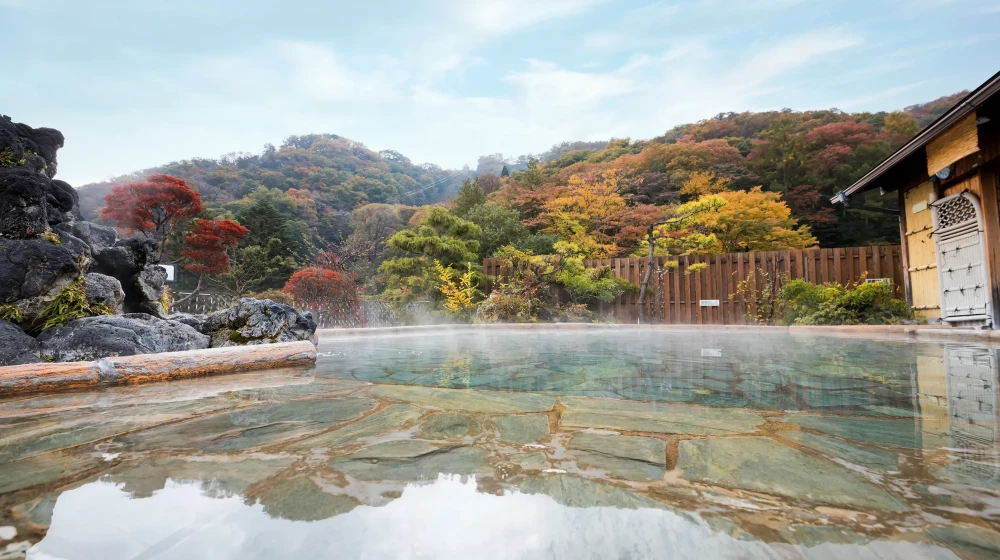
Types of Onsen
There are so many hot springs that some people may not know how to choose, or some people may not understand the hot spring culture of Japan in the first place. For such foreign visitors to Japan, this article has categorized and summarized not only the background of Japan's hot spring culture, but also the method of use, facilities, and quality of hot springs in an easy-to-understand manner.
You can use it to stay or not to stay. You don't necessarily have to stay at the accommodation to experience the hot springs on a day trip. Facilities are how hot springs are provided in the establishment. This section explains large public baths, open-air baths, indoor baths, private baths, in-room baths, and foot baths. The benefits and precautions of using hot springs at each facility are also introduced. The quality of springs is classified according to the main components contained in hot water.
After reading this article, you will gain knowledge of Japan's onsen culture and guidelines for choosing the perfect hot spring for your onsen trip.
What is Japanese Onsen?
Overview
In Japan, hot springs are defined by a law called the "Hot Springs Law" created in 1948. Hot springs have conditions stipulated by law, and those that meet these conditions can officially be called "hot springs" in Japan. Since hot springs contain a variety of ingredients, permission from the prefectural governor is required when using them in public baths or for drinking. In the application, it is stipulated in the Ministry of the Environment's "Guidelines for the Analysis of Mineral Springs" that an analysis report on the composition of the hot spring must be submitted together.
Among hot springs, hot springs that are high in certain hot spring substances and contribute to therapeutic purposes are called "therapeutic springs". Therapeutic springs are defined by the Ministry of the Environment's "Guidelines for Mineral Spring Analysis Methods" rather than the Hot Springs Law.
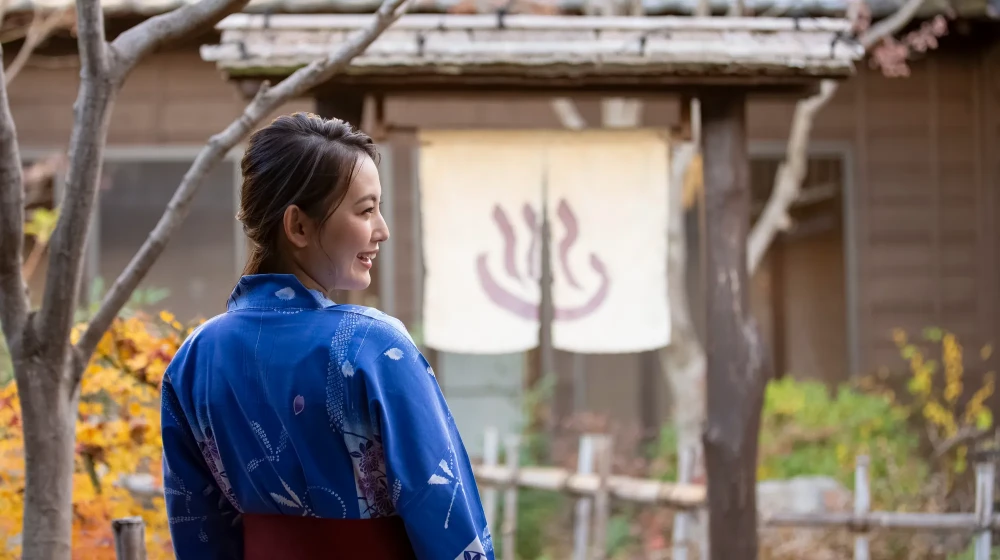
Definition under Japan Onsen Law
According to the definition of the Hot Springs Law, "hot springs are hot water, mineral water, steam, and other gases (excluding natural gas composed mainly of hydrocarbons) that come out of the ground and have the temperatures or substances listed in the Appendix."
The conditions in the attached table can be roughly summarized as the following three conditions. If even one of these three conditions is satisfied, it will be recognized as a "hot spring".
1. The temperature at which it is collected from the hot spring source must be at least 25°C.
→ if the temperature is above 25°C when it springs from the ground, it will become a hot spring even if the ingredients are the same as water.
2. 1,000 mg (1 g) or more of dissolved substances excluding gases must be contained in 1 kg of hot water.
→ if there is more than 1,000 mg (1 g) of dissolved substance, it will become a hot spring no matter how cold it is below 25 degrees Celsius.
3. Contains at least one of the specified 18 ingredients in the specified amount.
→Even if there are no dissolved substances of 1,000 mg/kg or more at 25°C or lower, if this condition is satisfied, it will become a hot spring.
When we think of hot springs in Japan, we generally mean "warm water". However, under the Hot Springs Law, even cold water is a hot spring if certain conditions are met. Steam and gas erupting from the ground are also included in hot springs. For this reason, "steam-created hot springs" that are artificially created by combining volcanic gas and well water are also hot springs.
Japanese Onsen culture
Onsen in nationwide
Japan is one of the world's leading hot spring countries. There are about 28,000 hot springs nationwide, and nearly half of them, about 13,000, are 42 degrees Celsius or higher. There are about 2900 hot spring resorts with accommodation. There are hot springs in all municipalities in the country.
(*End of March 2023: Reference: Environment Agency Data on Hot Springs Reiwa 4 Fiscal Year Hot Spring Usage Status)
Based on the blessed natural environment, Japan people have cultivated a unique hot spring culture since ancient times.
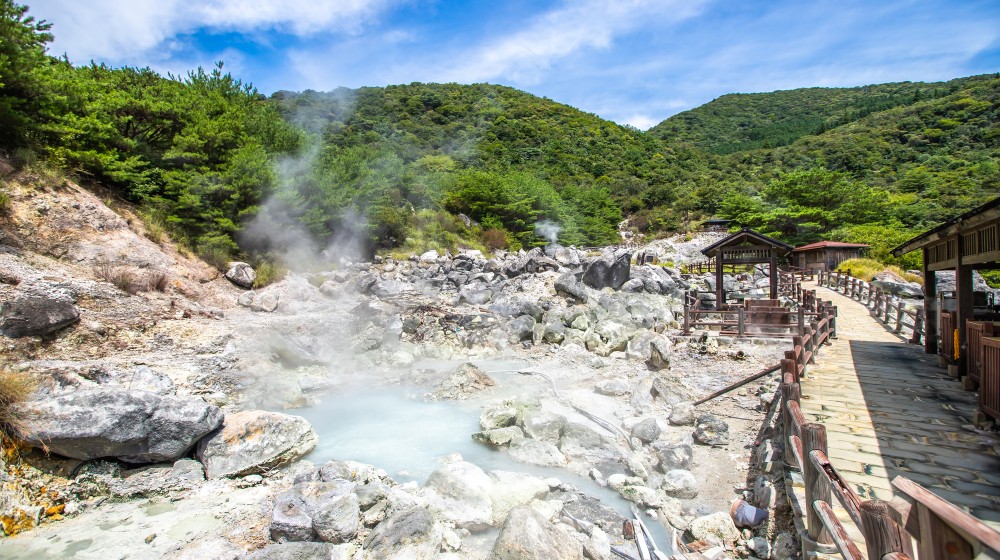
The reason why there are so many hot springs in Japan is related to geographical factors. Japan is not only included in some areas of the Pacific Rim orogeny, but is also strongly affected by the monsoon. Japan receives more than twice the world average in terms of precipitation. Japan is blessed with volcanic heat sources and water resources that produce hot springs.
The source of hot springs is groundwater that has seeped into the ground with rain, snow, and seawater. Groundwater is heated and erupts to the surface of the earth, containing components contained in volcanic magma and bedrock. Typhoons, rainy seasons, and snowfall create water resources that are the source of hot springs.
There are two large orogenic zones in the world: the Pacific Ring of Fire and the Mediterranean Himalayan orogeny. A place where the movement to create mountains and mountain ranges is active is called a volcanic belt. Places with active orogeny are prone to earthquakes and volcanic activity. The distribution of hot springs in the world coincides with these two volcanic belts.
Onsen culture and treatment
There are several countries in the world located on volcanic belts, and there are other countries besides Japan where hot springs spring up. What is the difference between the hot spring culture of those countries and the hot spring culture of Japan? The fact that hot spring resorts are popular as tourist destinations overseas is the same as in Japan, but there are many countries where the way to enjoy them is different.
Japan people bathe naked in hot water up to their necks and do not move still. The temperature of hot water preferred by Japan is 42~45°C. Japan people feel tired and comfortable when they soak in hot water. Many hot springs overseas have low temperatures, so you bathe as if you were swimming in a bathing suit. It's like swimming or bathing in a pool.
Hot springs are not the only thing that Japan take a hot bath in. There is a bath in the house of Japan people, and you can heal the fatigue of the day by soaking in the hot water. Westerners wash off the dirt on their bodies in the shower.

In Japan, hot spring towns are highly developed as tourist destinations, and accommodation facilities that make you feel the atmosphere of Japan are created. Enjoying not only the hot springs, but also the poetic scenery and cuisine of hot spring towns and inns is the way to enjoy hot springs in Japan. On the other hand, overseas, the aspect of leisure or recuperation is fully emphasized. In Europe, it is often recognized that hot spring bathing = medical practice.
At the root of the hot spring culture of Japan are the ideas of "Shinto" and "Buddhism".
Shinto is a religion unique to Japan based on ancient nature beliefs. Shinto does not have a guru or scriptures, and believes that gods dwell in all things such as mountains, megaliths, and trees. Since ancient times, Japan people have believed that water has the power to purify the mind and body. In Shintoism, the cleansing of the dirt and sins of the heart with water is called "zen". Doing meditation in a hot spring is called "descaling".
Buddhism was introduced to Japan, where there is a Zen culture, and a sutra called the "Greenhouse Sutra" was transmitted. The "Greenhouse Sutra" teaches that taking a bath can get rid of the seven diseases and obtain the seven blessings. The monks not only purified themselves by bathing, but also gave "almsgiving" to the common people in the temple. Almsgiving is the opening of baths in temples to provide bathing to the poor and sick. Through bathing, people learned about the cleanliness and healing effects of bathing.
Japan's hot spring culture can also be considered a fusion of Shinto's "Zen" and Buddhism's "Greenhouse Sutra". For Japan, hot springs mean "hot spring separation" and means to purify the mind. Unlike the Western culture of "washing away dirt from the surface of the body with a shower," Japan is a "culture of soaking in hot water" that cleanses the impurities of the mind.
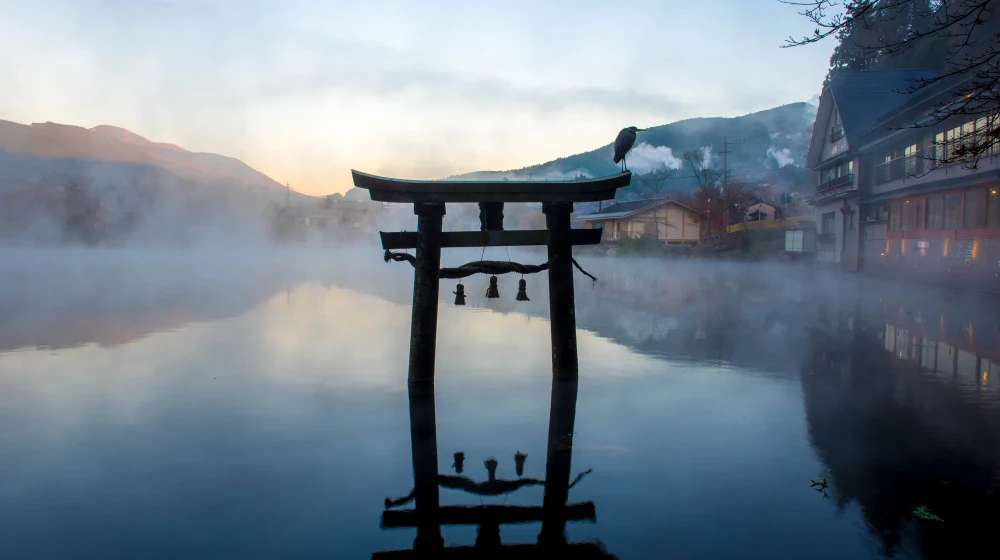
Since ancient times, hot springs have been called "rejuvenating hot springs" in Japan. Zen is closely related to "resurrection and rebirth," in which you are reborn as a new you. Japan people have carefully inherited and used hot springs that spring up naturally, with reverence for nature and gratitude for its blessings.
Japan has a long history of hot spring treatment, and it is said that there was a custom of hot spring healing about 1300 years ago. Hot spring healing is the treatment of illness and health recovery through hot spring bathing. Japan's hot spring resorts became tourist destinations after the Meiji period (1868-1912), and until then they were used as hot spring resorts.
In Japan, there are historic hot springs all over the country that were used for hot spring treatment, and they are still used by many people today. Since 2018, Japan's Environment Agency has been promoting "New Hot Spring Treatment," which combines hot spring healing and tourism.
Movement to register as an intangible cultural heritage
In Japan, hot springs have been used for hot spring healing since about 1300 years ago. Since then, hot springs in Japan have developed throughout the country in response to changes in the times and people's needs. In the process, various cultures such as architecture, food, beliefs, festivals, and medicine were born in Japan, centered on hot springs, and these cultures have been inherited to this day in various parts of Japan.
In 2020, "Finnish sauna culture" was inscribed on the UNESCO list of Intangible Cultural Heritage. In Japan, there is a movement to register hot spring culture as an intangible cultural heritage of UNESCO, defining it as "a broad lifestyle culture of the entire Japan nation that heals the mind and body through hot springs, which are a blessing of nature."
There are many hot spring resorts and accommodation facilities in Japan, but they have been declining since peaking in 2010 due to population decline, aging, and lack of successors. Those involved in hot springs, who are responsible for preserving and transmitting hot spring culture, are in a difficult situation.
If this situation continues, there is a risk that the hot spring culture that Japan people have cultivated over a long history will be lost. It is necessary to overcome this situation by registering it as an intangible cultural heritage, and to work on the revitalization of hot spring areas and the protection and inheritance of hot spring culture.
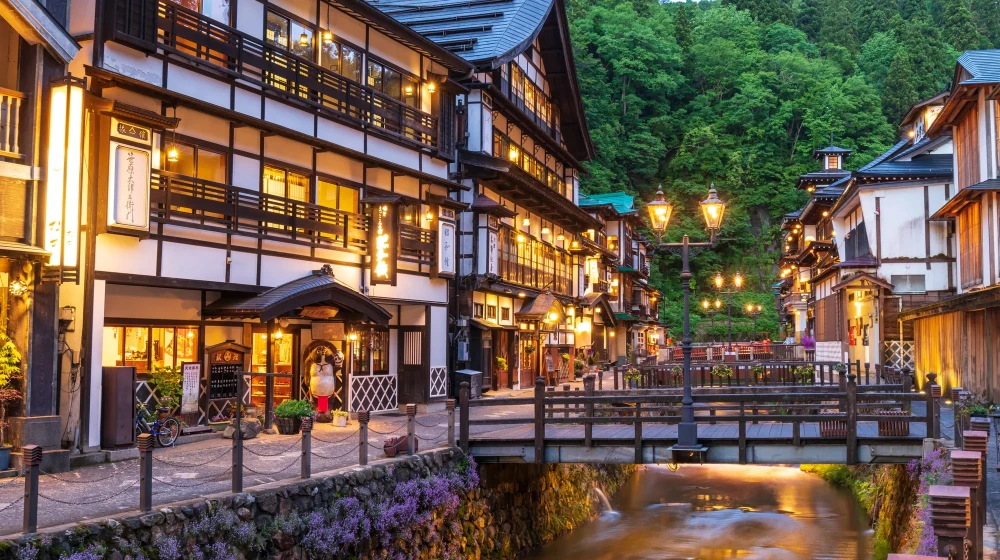
History of Onsen in Japan
In ancient times, there was already a relationship between hot springs and Japan people, as we can see from several books dating back about 1,300 years.
In Japan's oldest book, the Kojiki, Dogo Onsen in Ehime Prefecture appears. In Japan's oldest official history, the Japan Shoki, there is a record of the Emperor's hot spring cure. In the "Izumo Country Fudoki", the word "hot spring" was used for the first time, and five hot springs appeared, including Tamatsukuri Onsen in Shimane Prefecture. Tamatsukuri Onsen was spelled out, "Once you enter the hot water, your appearance will become beautiful, and if you enter it again, you will be cured of all diseases."
In addition, the Buddhist scripture "Greenhouse Sutra" was transmitted to Japan. The Greenhouse Sutra is a teaching of the merits and manners of bathing. In temples, "almsbathing" was practiced, in which baths were given to the common people, and the custom of bathing spread. Since it was forbidden to bathe naked by etiquette, both men and women bathed wearing a yubako (later a yukata). Over time, bathing clothing was simplified.
In the Middle Ages, warlords, samurai, and monks actively used hot springs, and hot spring resorts developed as hot spring resorts.
The hot springs that spring up naturally are called "Soyu" and were also used as communal hot springs in the community. Centered on "hot springs," hot springs are considered as a blessing of nature, and hot spring community has also developed to be managed and used by everyone.
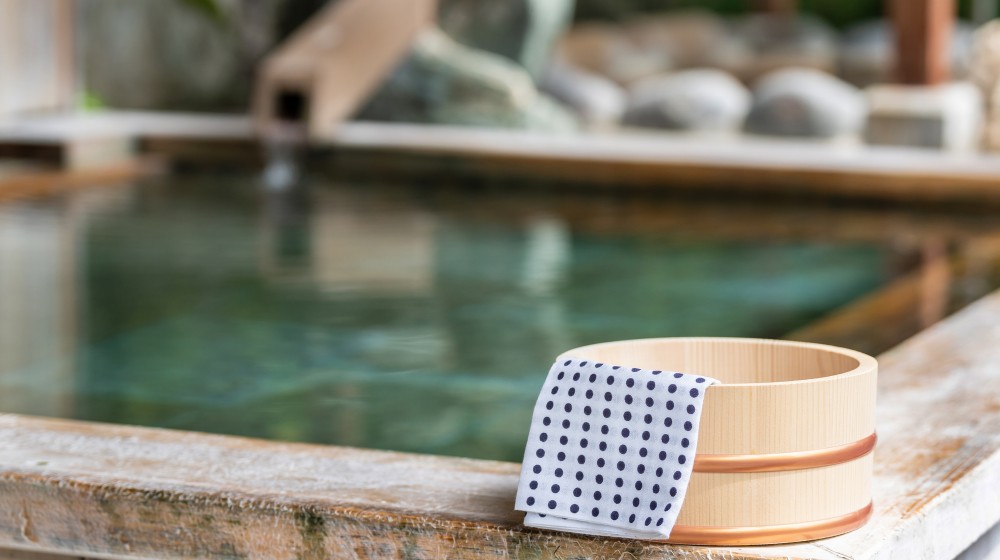
In the early modern period, hot springs spread to the general public and the use of hot springs as a hot spring treatment became more active. Around this time, both men and women in Japan began to bathe in hot springs with a washcloth.
In modern times, hot spring resorts began to shift from hot springs to recreational areas and tourist destinations. Along with the development of new hot springs, hot springs are drawn to each inn, and the number of cases where bathrooms are built in the inns is increasing. With the rapid economic growth after the war, many hot spring resorts changed from hot spring resorts to tourist hot spring resorts. With the development of the transportation network, many people have come to visit the hot spring resort.
In modern times, tourism has become popular, and hot spring resorts are popular as places of relaxation and fun for a variety of people.
How to use Onsen?
Day trip Onsen
A one-day hot spring is a service that allows you to use communal baths and hot springs managed by the community at a relatively low price without staying overnight. One-day hot springs are also called drop-in hot springs.

Hot spring resorts in Japan often have public baths and communal baths where you can take a day trip. In the historic hot spring resort, there is a communal bath that is used and managed by the locals in their daily lives. Large public baths are a complex. There are a wide variety of baths, and there are facilities where you can eat and massage.
If an inn or hotel has a large public bath, you can take a bath without staying overnight. Some famous hot spring towns offer day-trip hot springs throughout the city. If you purchase a bathing ticket called a "bathing bill", you can freely bathe in multiple or all of the hot springs in the hot spring town. Rather than taking a day trip to a hot spring at an inn or hotel, you can bathe in multiple hot springs.
The advantage of a one-day hot spring is that there is no accommodation cost, so travel costs can be reduced. Even at a long-established inn with a high threshold, you can enjoy the feeling of staying. Japan is a hot spring powerhouse, so there is a hot spring town very close to the city center. Even if you don't go out, you can take a day trip to change your mood and heal your fatigue.
Staying at Onsen ryokan
It is not a day trip, but a style of staying at a onsen ryokan and enjoying the hot spring. You will stay at an inn or hotel with an onsen. Depending on the accommodation, bath facilities such as open-air baths and cypress baths, as well as the effects of onsens, differ.
You can also choose accommodation based on the facilities and location of the bath, such as a bath with a spectacular view of the forest and the sea, or an open-air bath where you can take a bath while looking at the starry sky at night.
The property offers a variety of plans for travelers, including local cuisine and traditional craft experiences. There is also a day-trip hot spring plan where you can use the bath without staying overnight.

In the hot spring town where the accommodation is located, there may be a communal bath (outdoor bath) that has been used by local people for a long time. You can experience many things in the area by staying at a hot spring resort and visiting the outdoor hot springs. One of the advantages is that you can take a walk around the hot spring town and sightseeing around the area while touring the outdoor hot springs.
Onsen facilities
Public Bath
Open air bath
An open-air bath is a bath that is installed outdoors or outdoors without a roof or fence. There may also be a roof to protect from the sun, rain, snow, and removal.

The open-air bath is a bath with a sense of freedom, and it is attractive to take a bath while enjoying the natural scenery.
In the open-air bath, you can feel nature and the changes of the four seasons. You can bathe in the hot springs while looking at the sea and the starry sky, listening to the murmur of the river and the chirping of birds. The atmosphere of the hot springs changes depending on the season, with autumn leaves in autumn and snowy scenery in winter. While relaxing in the hot springs, you will feel like you are one with nature. There are also open-air baths in the city where you can enjoy hot springs in an atmosphere like a Japan garden.
In the open-air bath, be careful of heat shock and dizziness. Unlike general bathrooms, open-air baths have a large temperature difference between the bathroom and the outside. Sudden changes in temperature put a strain on the heart, causing heat shock and dizziness. Be especially careful in cold winters. Before entering the bathtub, pour hot water on your body to adjust your body to the temperature of the hot spring, and heat the dressing room in advance with a heater to prevent temperature differences.
Indoor bath
An indoor bath is a large public bath in a ryokan. The indoor bath is owned by a ryokan. In contrast to the indoor bath, the communal bath outside is called the outdoor bath.

There is a historical reason why the outdoor and indoor baths were born. Until the technology of digging hot springs was developed, hot springs were limited to natural sources. It was not possible to distribute hot springs to each inn, so the local people jointly managed and used the hot springs that naturally gushed out of the natural springs. The inns in the vicinity were only for lodging and did not have a bath.
When transportation was improved, more and more people visited hot spring resorts for sightseeing. With the increase in tourists and the development of technology for digging hot springs and distributing hot water, each ryokan began to have its own bath.
Private bath
A private bath is a service that allows you to reserve the bath in the accommodation at the desired time you reserved. There is also a "family bath". It is ideal for families, couples, and couples who come on a hot spring trip and want to spend a relaxing time without taking a bath in the large public bath divided into men and women.
The point to note is that you should be aware of the appointment time and do not make a lot of noise. Even if you can enjoy the hot springs without hesitation in a space that can be monopolized, the voice resonates unexpectedly. In order to be able to leave the room within the reserved time, make sure you have plenty of time to change clothes and make up after getting out of the bath.
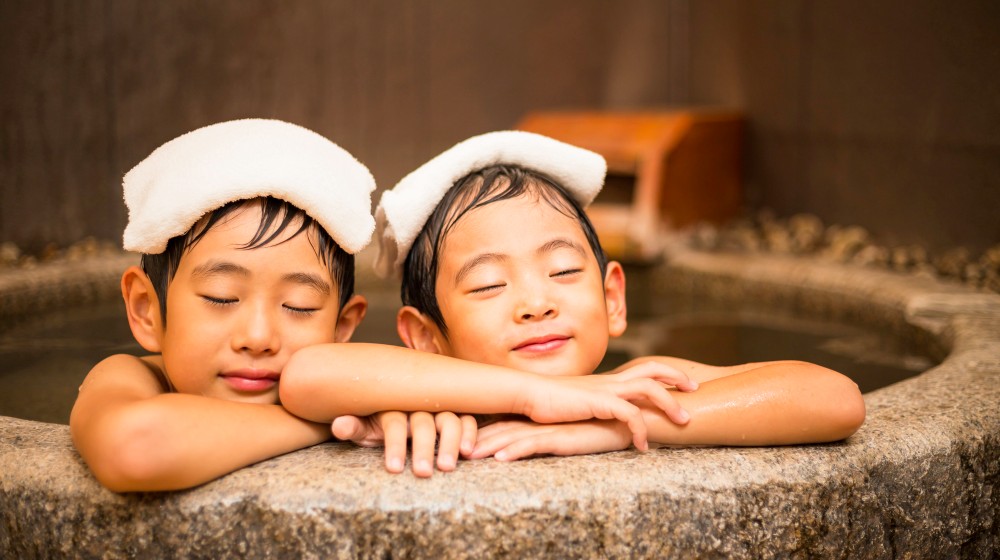
Bath in room
It is a bath in the each guest room. The attraction is that you can enjoy the hot springs whenever you want to take a bath. You can also secure a private space.
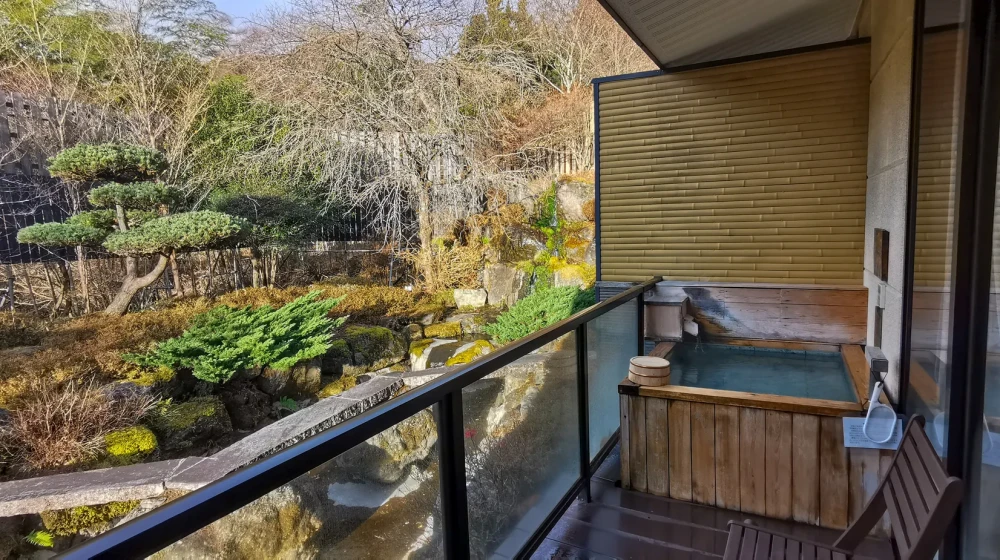
Families with small children may be careful in large public baths where many people bathe. In the in-room bath, there is no need to worry if the child is a little noisy. You can take a leisurely bath at a family pace.
The open-air bath is attractive because you can take a bath while looking at the spectacular view of nature. The open-air bath is outdoors and you may not be able to relax, but you can enjoy your own time with the open-air bath in the guest room.
The atmosphere of the hot spring changes depending on the time of day, evening, and night. It is also unique to the in-room bath that you can freely bathe at times when the scenery is beautiful, such as sunset at sunset, night view, and sunrise at dawn.
Footbath
A foot bath is a partial bath in which only the feet (below the knees) are bathed. Foot baths have the effect of relieving fatigue, relaxing the mind and body, and reducing stress. Unlike a full-body bath, where you soak your whole body in a hot spring, there is less burden on your body. It is easy to take a bath while wearing clothes, so you can easily challenge it.
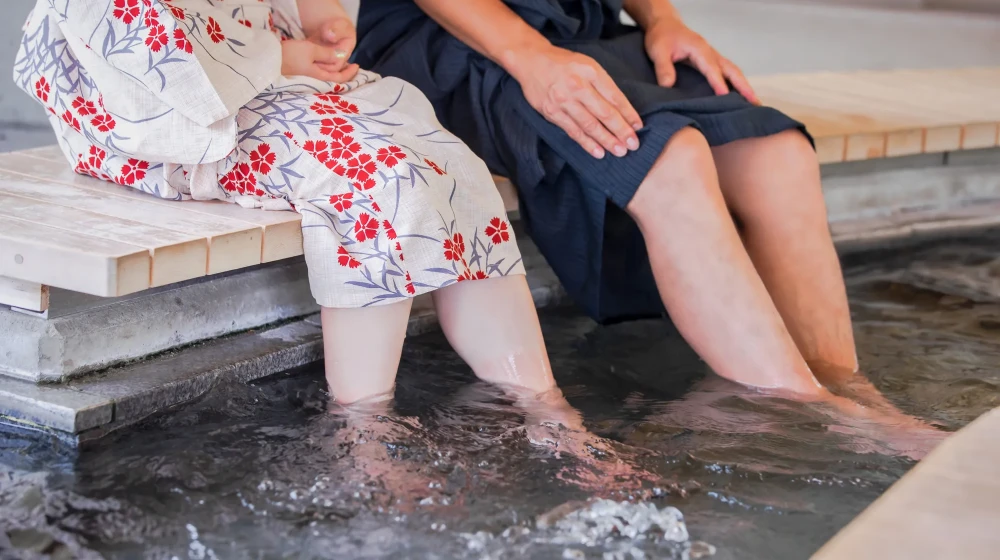
Some hot spring towns have free foot baths. Foot baths promote blood circulation in the feet, where blood circulates easily and gets cold. It is recommended for taking a break when you are tired from walking around the hot spring town or in the cold winter. If the chairs around the footbath are wet, they can be slippery, so be careful.
Search by Prefecture
Search by Onsen area
- Hokkaido
- Nagano
- Akita
- Kanagawa
- Yamagata
- Shizuoka
- Gifu
- Hyogo
- Wakayama
- Yamanashi
- Kumamoto
- Oita
- Fukushima
- Tochigi
- Gunma
- Ishikawa
- Shimane
- Ehime
- Saga
- Kagoshima
